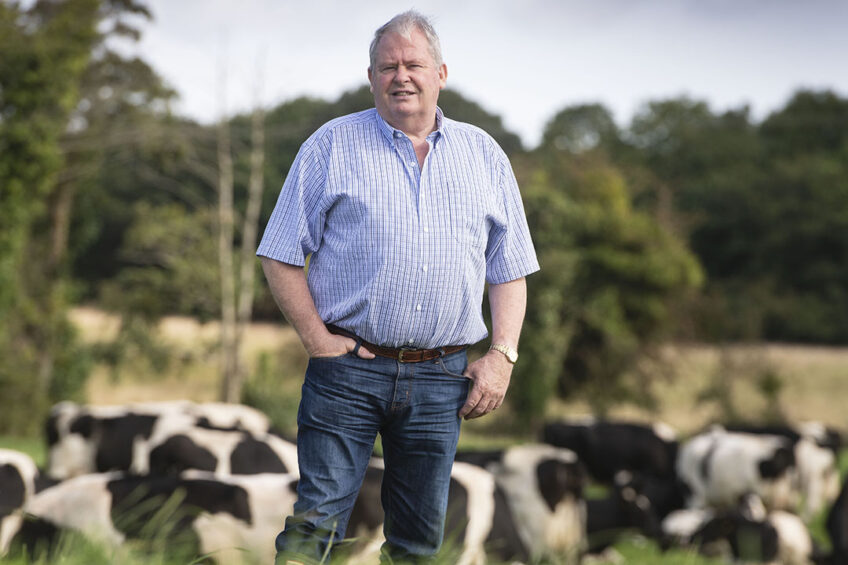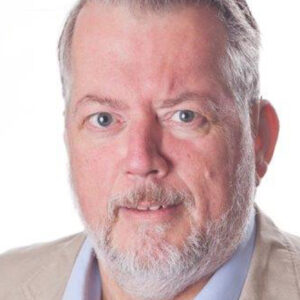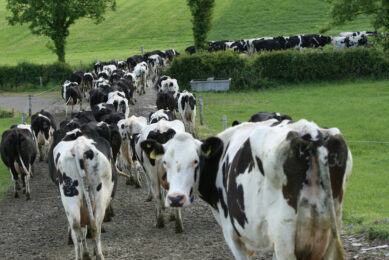Glanbia: Ireland’s number one milk processor in the spotlight

Martin Keane, chairman of the board of Ireland’s Glanbia, number one milk processor. In this interview he talks about the Irish dairy farming, investments and organic farming in Ireland.
Martin Keane, chairman of the board of Ireland’s number one milk processor, has a clear course in mind. He thinks Glanbia’s growth rate in milk collection should be reduced compared to the last few years and that the company should more actively use its advocacy in marketing its products. The company’s name already implies this role: Glan bia is Celtic for clean food. “Our cows graze for up to 300 days per year and have a very low ecological footprint. However, we forgot to use that in our marketing, which we will definitely change.”
Can you describe Irish dairy farming and Glanbia in 2010, 2020 and 2030?
“Around 2010, the average Irish dairy farmer had 60 dairy cows. Glanbia processed a little over 1,5 billion kilogrammes of its members’ milk. Because the milk quota was terminated and our members wanted to increase their production significantly, we had to substantially invest in processing capacity. Financing this through the exchange – the company was partly listed – was impossible. The members then decided to use part of their assets in the cooperative to buy processing capacity from the listed company and started a joint venture with the listed company. Glanbia Ingredients later merged with the Irish assets of the listed company and then became Glanbia Ireland. Glanbia Ireland, which processes the milk and sells farm inputs, is a joint venture 60% owned by the Co-operative and 40% by the stock market listed Glanbia plc. The Glanbia cooperative now has 31,5% of the publicly quoted company’s shares and over 20% is directly in the name of members. So now, more than half of the company is directly or indirectly farmer owned.

The average dairy farmer now owns 101 dairy cows and we process 3 billion kilogrammes of milk. That increase will be significantly less, leading up to 2030, than the 10% growth rate we saw in the past years. This is not sustainable. We cannot keep on investing € 100 million a year in expansion and we cannot create the same value growth as we did in the past years.”
Which growth rate do you think is sustainable?
“The global dairy market grows with 1,5 to 2% annually. This is mainly due to an increase in middle class, based on taste, availability and the health benefits of milk. With a maximum growth in sales of 2% every year, a structural production growth of 5 to 10% annually does not work.”
But Irish farmers expand like crazy; an extra third in 4 years’ time. How will that continue?
“I do not want a quota system: this puts the brakes on all potential and I do not want a repetition of 30 years in chains. Every dairy farmer should be able to choose his or her own direction. However, we do not have the luxury of sitting on our hands. We must match our members’ expectations and their appetite for expansion with Glanbia’s needs and market opportunities. I do see this unlimited growth ending soon.”
The Dutch have experience in this field. Does a form of limitation of the possibility to supply milk also appeal to you?
“Yes, this is inevitable. Worst case scenario, we have to say, ‘we do not want additional milk’. Looking at the complete playing field, it is logical to say that we have to intervene and move towards a more moderate rate of production growth.”
Royal FrieslandCampina (RFC) has already found a system for this. Would this work for Glanbia too?
“I cannot say anything without the board’s support. What I can say is this: we are looking at the issue. Rule number 1 in a dairy cooperative is that we process all the milk our members supply. But that does not have to be done at the same price. So, pricing might be a barrier within this policy. The alternative is that we say, ‘we offer the opportunity for expansion, but do write a cheque so we can invest’. Nothing has been proposed or decided yet, though.”
Limitation nearly led to an uprise in the Netherlands. Are your members ready for this?
“Not all farmers will be happy when something like this is introduced. However, there will probably be some degree of understanding if we implement it honestly and openly and face reality: that the alternative is a weaker milk price because we must sell too much milk in commodities. We do not want to sell additional products in low-yielding markets and have a riot on our hands in the rest of the European Union because we are spoiling the total milk price. Do not underestimate this, we need to manage all of this too.”
Does the companies’ strong growth cause problems regarding support?
“We have to have societal acceptance, our neighbours’ social acceptance and the likeability factor from other sectors. That threatens to be put under pressure because of intensification. The average farmer now owns a third more cows than in 2015. The ecological footprint has grown. Dairy farmers make good money and have a reasonably stable income, especially compared to other agricultural sectors. We have to take care that beef cattle farmers or arable farmers do not start accusing dairy farmers of taking over. Keeping beef cattle is financially difficult right now because the most important market is gone. Dairy farmers cannot fatten the little bulls themselves, they must be marketed. In the European Union, slaughter of these animals is not accepted in the first few weeks. This means we must deliver good calves as well. The board realises this, but this realisation is a lot more difficult for the farmers themselves.”
Will Glanbia start making demands for the use of bulls to support beef farmers?
“We will not directly start making demands, but we do give off a clear signal. We have recently launched a new programme called the Twenty20 Beef Club in partnership with one of Ireland’s leading beef processors, Kepak. This will encourage dairy farmers to breed high quality beef calves from the dairy herd. It offers a price contract and farm management advice. Extreme calf mortality in the first weeks is unacceptable. When a farmer has to deal with a very high mortality rate in bullcalves and also has a normal or low mortality in heifers, there is something terribly wrong. Cattle farmers know where their problems are. Yes, milk refusal is possible eventually, but we do not want to use that big stick. And we do not have to, because we gave off the signal that we could use this means in good time. This message really came across.”
Irish dairy farming is extensive and pastures nearly year-round. Why do you hardly mention that in your marketing?
RFC has very cleverly achieved that it can sell 120/6 as grass-based to customers. Our cows pasture for up to 300 days a year and during the 2 months in winter when they stop producing milk, they are fed with grass products. Our companies have mostly been in the family for 5 generations. This is all perfect communication material. So, we have launched marketing initiatives such as origin green and truly grass-fed. This has made us big in the United States, where we are the largest producer of cheddar. In Germany, the Kerrygold brand, marketed by the joint Irish dairy cooperations is a large player. Consumers are more and more sensitive to these kinds of soft skills and the feeling behind them. You see that everyone tries to make this connection to nature, and we have not done this enough, so we will step up our game. There is much potential there.”
 Name: Martin Keane (63) Name: Martin Keane (63)Company: Glanbia Function: Chairman of the Glanbia cooperative and member of the Group board. Keane owns a dairy farm with 110 dairy cows at 70 hectares of pasture in Erril, virtually in the middle of Ireland. |
Irish companies are nearly organic. Why doesn’t Glanbia say: everything organic?
“Half of our members probably meet the mark, but do consumers want to pay for the additional costs? This is the big challenge. We would have to earn twice as much for our product. You get hit twice: lower production and higher costs. It might be feasible, but it does take a lot of time.”
Are you looking at mergers?
“We mainly focus on joint ventures, but we are certainly open to large-scale cooperation, even mergers. However, it should add something different and new to the mix. An absolute condition should be access to the larger markets in the European Union. A cooperation with RFC or Arla would be an exciting prospect. This would give us a consumer focus we do not have now because of our small domestic market. We only have 4,5 million inhabitants, 90% of our production needs to be exported. Arla and FrieslandCampina have 45 million consumers nearby and a huge amount of marketing knowledge. This can add a new dynamic to our business: we add both sustainability and the story! The 300 days, the 5th generation dairy farmer, outdoor, healthy, lifestyle. We cannot keep to ourselves. Therefore, we started our cooperation with Royal A-ware. We will build a cheese factory together. A-ware’s basic and straightforward way of doing business suits Glanbia. 120 years of Royal A-ware: they must be doing something extremely right.
We had to invest in capacity, but why invest in a market that is already overloaded? Why in Cheddar? That is only one 5th of the cheese market. Investing in a large market is preferable, to spread risks and to stop relying on England that already buys 15 to 20% of Glanbia’s products. This is what we got after our cooperation with A-ware. We know that the first 3 or 4 years will not be pretty, that we need to add money. We can limit that with good management. Both A-ware and Glanbia have this experience with new plants. We always get everything done in time and within budget. Because being too late or having too many costs will cause problems. The cheese market is growing, this only offers opportunities. I do not see a downside. Our global experience will ensure we will bring this to a successful close, especially in combination with A-ware’s entrepreneurial spirit.”
Going to China and other markets is not an option?
“We are selling some products to China, India, the Middle-East and other new markets. However, we are small scale and the rules of engagement in China change fast and often. Many western companies have experienced significant challenges in gaining a foothold in that market. It is my understanding that RFC is having a bad experience in China with its baby food. Part of its € 1 billion turnover has evaporated in the past months because of changing rules.”
Will the Irish milk price remain lower than prices in the rest of the European Union?
“Probably, yes. Our product mix determines our milk price. We do not have a large consumer market behind us, which pays a lot better than the commodity market for which we produce. Over 90% must leave the island, which leads to additional costs. We aim for 3,2% profit after taxes. That is far more challenging than on the continent and puts pressure on the milk price compared to our competitors. These extra costs ensure that we always have to pay several cents per kilogramme less, but we can explain that perfectly. Our farmers have lower costs due to the seasonal milk production system. Farmers that produce all year round milk receive an additional bonus during the winter months and this milk price would be similar to a continental price.”
Join 13,000+ subscribers
Subscribe to our newsletter to stay updated about all the need-to-know content in the dairy sector, two times a week.










